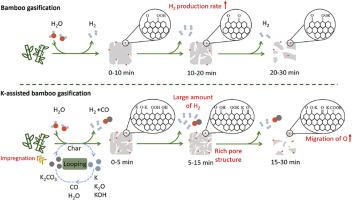竹材k助气化多孔炭与富h2合成气联产的协同调控机理
IF 6.2
2区 工程技术
Q2 ENERGY & FUELS
引用次数: 0
摘要
多孔炭和富h2合成气的多联产是生物质中碳和氢元素充分和高价值利用的关键技术。本研究采用固定床热解-气化系统,研究了k辅助竹材气化过程中H2和多孔碳的协同演化及其调控机制。结果表明:由于蒸汽活化,随着气化时间的延长,炭的产氢速率和理化性质均先升高后降低,在气化过程中期达到峰值;氢气转化率进一步表明部分气化生产效率较高,有利于多联产。K加速了炭和H2的演化,提高了它们的质量,最终实现了31.5 mmol/g H2和多孔碳的多代生成,SBET为1917 m2/g。此外,K促进了碳中氧的富集,特别是O=C- or和C=O基团在碳表面的掺入,从而提高了碳的功能适用性。本文章由计算机程序翻译,如有差异,请以英文原文为准。

Synergetic regulation mechanism of K-assisted bamboo gasification for porous char and H2-rich syngas poly-generation
Poly-generation of porous char and H2-rich syngas is a key technology for the full and high-value use of carbon and hydrogen elements in biomass. In this study, the synergistic evolution and regulation mechanisms of H2 and porous carbon during K-assisted bamboo gasification were investigated using fixed-bed pyrolysis-gasification system. The results show that, due to steam activation, both the H2 production rate and the physicochemical properties of char initially increase and then decline with prolonged gasification time, reaching their peak in the middle stage of the process. The hydrogen conversion rate further indicates that partial gasification achieves higher production efficiency, which is favorable for the poly-generation. K accelerates the evolution of both char and H2, enhancing their quality and ultimately enabling the poly-generation of 31.5 mmol/g H2 and porous carbon with a SBET of 1917 m2/g. Moreover, K promotes oxygen enrichment in char, particularly the incorporation of O=C-OR and C=O groups on the char surface, thereby improving the functional applicability of the carbon.
求助全文
通过发布文献求助,成功后即可免费获取论文全文。
去求助
来源期刊

Journal of The Energy Institute
工程技术-能源与燃料
CiteScore
10.60
自引率
5.30%
发文量
166
审稿时长
16 days
期刊介绍:
The Journal of the Energy Institute provides peer reviewed coverage of original high quality research on energy, engineering and technology.The coverage is broad and the main areas of interest include:
Combustion engineering and associated technologies; process heating; power generation; engines and propulsion; emissions and environmental pollution control; clean coal technologies; carbon abatement technologies
Emissions and environmental pollution control; safety and hazards;
Clean coal technologies; carbon abatement technologies, including carbon capture and storage, CCS;
Petroleum engineering and fuel quality, including storage and transport
Alternative energy sources; biomass utilisation and biomass conversion technologies; energy from waste, incineration and recycling
Energy conversion, energy recovery and energy efficiency; space heating, fuel cells, heat pumps and cooling systems
Energy storage
The journal''s coverage reflects changes in energy technology that result from the transition to more efficient energy production and end use together with reduced carbon emission.
 求助内容:
求助内容: 应助结果提醒方式:
应助结果提醒方式:


